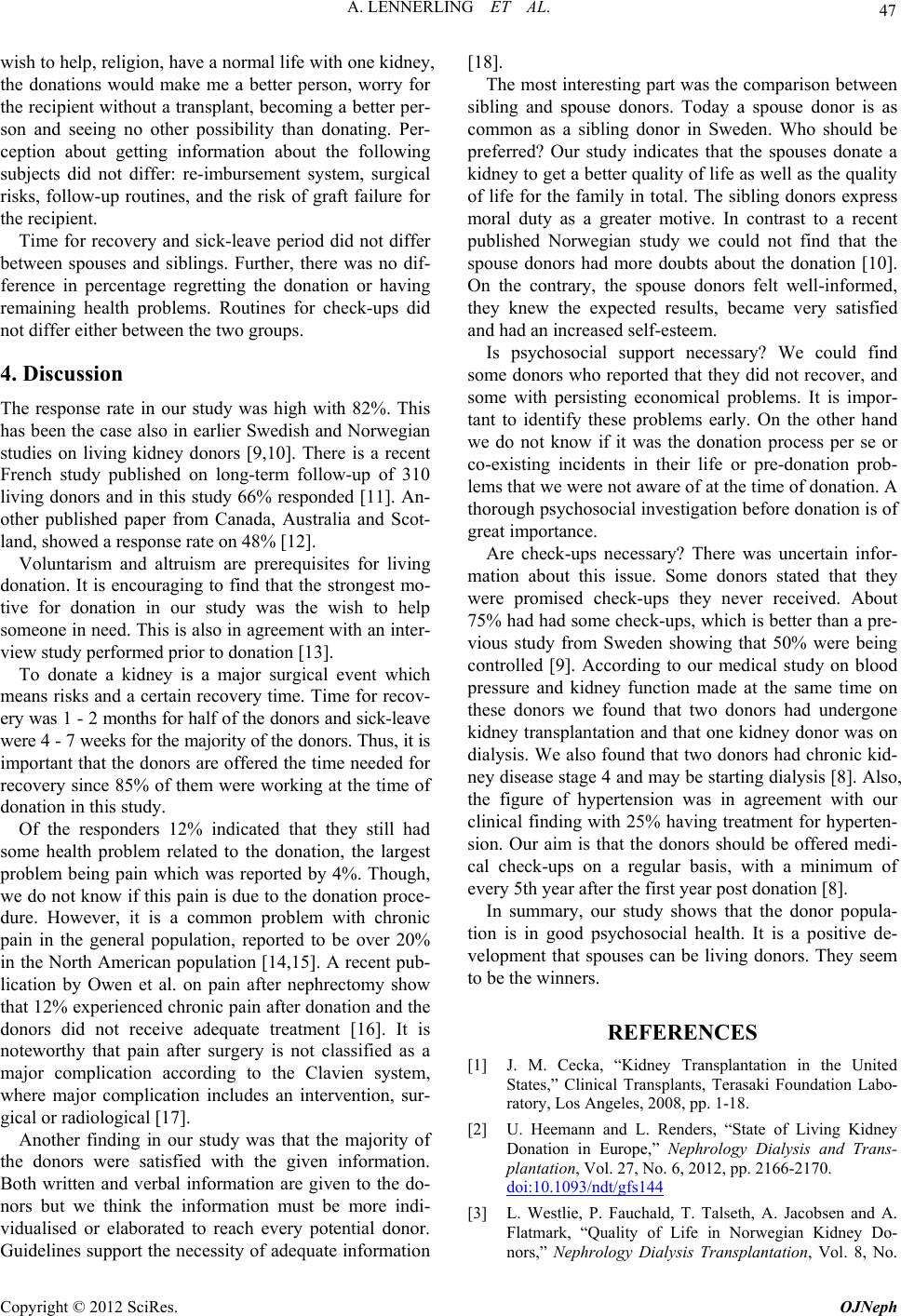
A. LENNERLING ET AL. 47
wish to help, religion, have a normal life with one kidney,
the donations would make me a better person, worry for
the recipient without a transplant, becoming a better per-
son and seeing no other possibility than donating. Per-
ception about getting information about the following
subjects did not differ: re-imbursement system, surgical
risks, follow-up routines, and the risk of graft failure for
the recipient.
Time for recovery and sick-leave period did not differ
between spouses and siblings. Further, there was no dif-
ference in percentage regretting the donation or having
remaining health problems. Routines for check-ups did
not differ either between the two groups.
4. Discussion
The response rate in our study was high with 82%. This
has been th e case also in earlier Swedish and Norwegian
studies on living kidney donors [9,10]. There is a recent
French study published on long-term follow-up of 310
living donors and in this study 66% responded [11]. An-
other published paper from Canada, Australia and Scot-
land, showed a response rate on 48% [12].
Voluntarism and altruism are prerequisites for living
donation. It is encouraging to find that the strongest mo-
tive for donation in our study was the wish to help
someone in need. This is also in agreement with an inter-
view study performed prior to donation [13].
To donate a kidney is a major surgical event which
means risks and a certain recovery time. Time for recov-
ery was 1 - 2 months for half of the donors and sick-leave
were 4 - 7 weeks for the majority of the donors. Thus, it is
important that the donors are offered the time needed fo r
recovery since 85% of them were working at the time of
donation in this study.
Of the responders 12% indicated that they still had
some health problem related to the donation, the largest
problem being pain which was reported by 4%. Though,
we do not know if this pa in is due to the donation proce-
dure. However, it is a common problem with chronic
pain in the general population, reported to be over 20%
in the North American population [14,15]. A recent pub-
lication by Owen et al. on pain after nephrectomy show
that 12% experienced chronic pain after donation and the
donors did not receive adequate treatment [16]. It is
noteworthy that pain after surgery is not classified as a
major complication according to the Clavien system,
where major complication includes an intervention, sur-
gical or radiological [17].
Another finding in our study was that the majority of
the donors were satisfied with the given information.
Both written and verbal information are given to the do-
nors but we think the information must be more indi-
vidualised or elaborated to reach every potential donor.
Guidelines support the n ecessity of adequate information
[18].
The most interesting part was the comparison between
sibling and spouse donors. Today a spouse donor is as
common as a sibling donor in Sweden. Who should be
preferred? Our study indicates that the spouses donate a
kidney to get a better quality of life as well as the quality
of life for the family in total. The sibling donors express
moral duty as a greater motive. In contrast to a recent
published Norwegian study we could not find that the
spouse donors had more doubts about the donation [10].
On the contrary, the spouse donors felt well-informed,
they knew the expected results, became very satisfied
and had an increased self-esteem.
Is psychosocial support necessary? We could find
some donors who reported that they did not recover, and
some with persisting economical problems. It is impor-
tant to identify these problems early. On the other hand
we do not know if it was the donation process per se or
co-existing incidents in their life or pre-donation prob-
lems that we were not aware of at the time of donation. A
thorough psychosocial investigation before donation is of
great importance.
Are check-ups necessary? There was uncertain infor-
mation about this issue. Some donors stated that they
were promised check-ups they never received. About
75% had had some check-ups, which is better than a pre-
vious study from Sweden showing that 50% were being
controlled [9]. According to our medical study on blood
pressure and kidney function made at the same time on
these donors we found that two donors had undergone
kidney transplantation and that one kidney donor was on
dialysis. We also found that two donors had chronic kid -
ney disease stage 4 and may b e starting dialysis [8]. Also,
the figure of hypertension was in agreement with our
clinical finding with 25% having treatment for hyperten-
sion. Our aim is that the donors should be offered medi-
cal check-ups on a regular basis, with a minimum of
every 5th year after the first year post d ona t ion [8].
In summary, our study shows that the donor popula-
tion is in good psychosocial health. It is a positive de-
velopment that spouses can be living donors. They seem
to be the winners.
REFERENCES
[1] J. M. Cecka, “Kidney Transplantation in the United
States,” Clinical Transplants, Terasaki Foundation Labo-
ratory, Los Angeles, 2008, pp. 1-18.
[2] U. Heemann and L. Renders, “State of Living Kidney
Donation in Europe,” Nephrology Dialysis and Trans-
plantation, Vol. 27, No. 6, 2012, pp. 2166-2170.
doi:10.1093/ndt/gfs144
[3] L. Westlie, P. Fauchald, T. Talseth, A. Jacobsen and A.
Flatmark, “Quality of Life in Norwegian Kidney Do-
nors,” Nephrology Dialysis Transplantation, Vol. 8, No.
Copyright © 2012 SciRes. OJNeph